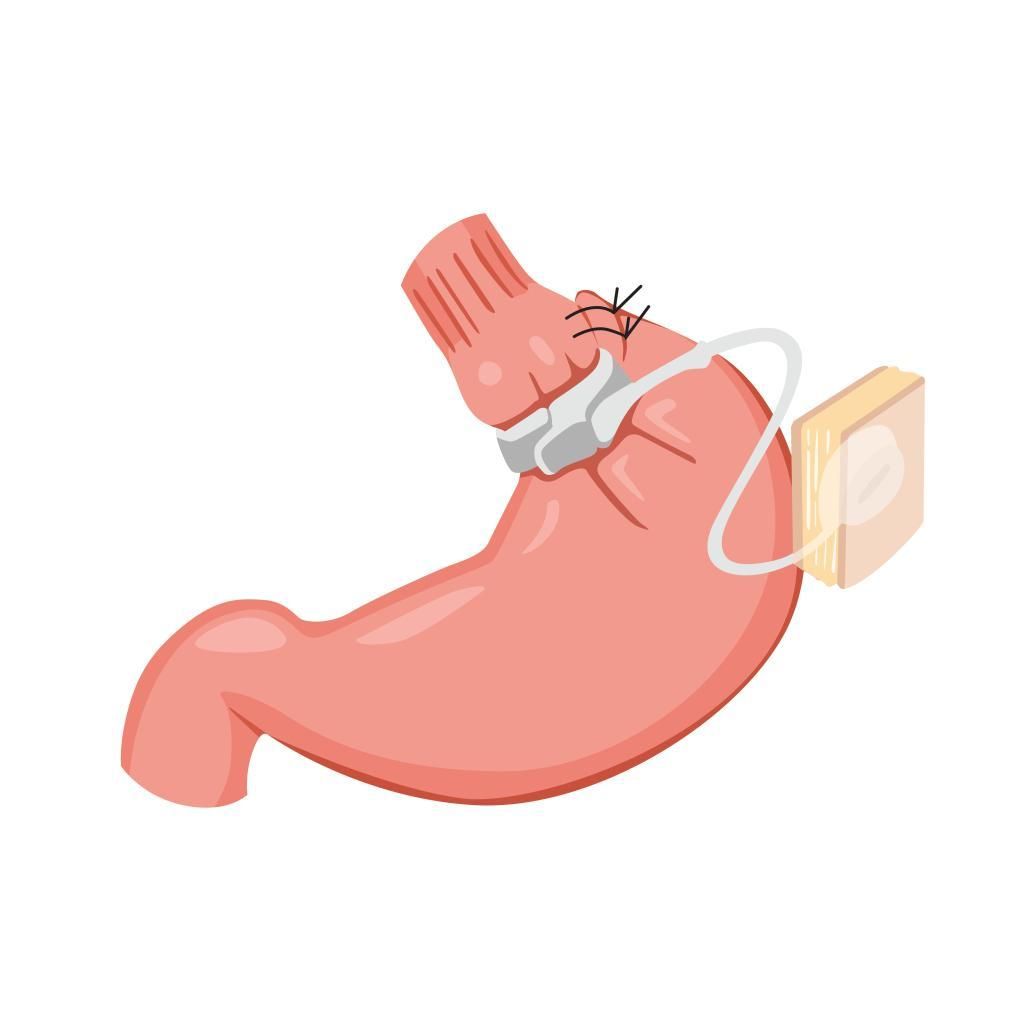Gastric Band
What is the Gastric Band?
The adjustable gastric band (sometimes called a Lap Band), of which there are various brands, involves placing a soft silicone band around the upper section of the stomach. This creates a small pouch above the band, reducing the stomach's capacity.
These bands feature an inflatable balloon along its inner side, connected through tubing to an access port beneath the skin on the abdomen.
By injecting saline into this access port, the band can be adjusted or tightened, which helps limit the amount of food intake and enhances the feeling of fullness or satiety.
At one time, this operation was a very common form of weight loss procedure. Due to various problems that can arise and many better options being available, it is virtually never done in Australia anymore. At Hunter Weight Loss, however, we do remove a lot of gastric bands for a variety of reasons.

Do you offer gastric bands at Hunter Weight Loss?
No. Whilst some patients have had bands placed with good results over many years, we know that for most patients, the weight loss outcomes for gastric bands are not good. Gastric bands often cause problems with stomach and oesophagus function, so we don’t offer this operation. Gastric banding operations have been almost completely replaced with more effective and safer operations. At Hunter Weight Loss, we feel that virtually every lap band that has been placed will eventually need to be removed sooner or later.
Care for Existing Band Patients
At Hunter Weight Loss, we can assist you if you already have a band. If your original surgeon is no longer available, we can perform band adjustments (filling and deflating) in our office.
Complications of Lap Bands
- Food intolerances: Due to the constriction of the band on the upper stomach, many patients have difficulty with various foods, which can cause nausea, vomiting and difficulty swallowing
- Reflux: Reflux or heartburn is quite common following lap band placement. This is due to acid being held up and forced into the oesophagus by the band.
- Band slippage: The band may move from its original position and then cause issues with the stomach being able to empty. Occasionally, this can develop into a very serious complication.
- Band erosion: Rarely, the band can erode into the stomach. If this happens, the port may become infected, or the patient no longer be aware of any restriction. This is a more complicated scenario to fix than a simple slipped band.
- Inadequate weight loss: On average, the lap band procedure is not very effective compared to other more modern operations. If you have had a band placed but need more help losing weight, come and see our surgeons, and they will go through the options with you.
What should I do if I have a Lap Band?
This depends on your circumstances. Most patients have their bands removed after seven to ten years. This may be due to complications, quality of life, or the band just not being effective. At Hunter Weight Loss, we can remove your lap band and discuss conversion to another procedure, as appropriate. If you have issues with your band, you should have it removed.
Reasons to Have a Gastric Band Removed
- Inadequate weight loss or weight regain: If your personal weight loss goals have not been met, or you are still experiencing issues from weight-related illness, conversion to an alternate weight loss procedure may be indicated.
- Band intolerance: If your lap band is causing problems swallowing, reflux or nausea, this is often a reason to have it removed.
- Band slippage: If the band has moved and is no longer where it is supposed to be, there is a high likelihood it will cause issues with the function of your stomach. Whilst repositioning is possible, we suggest removing the band because lap bands are usually not very helpful.
- Oesophageal problems: It is not uncommon for patients with gastric bands to develop issues with their oesophagus, which results in difficulty swallowing. Removal of the band may improve this.
What Happens During Gastric Band Removal?
- The patient is brought into the operating theatre, and a general anaesthetic is given.
- The surgeon makes 4-5 small incisions for the surgical instruments,
- The band is freed up from the stomach and released. It is then removed entirely.
- The reservoir, or port, is then removed from under the skin.
- Over time, the stomach and oesophagus often return to normal.
What to Expect After Gastric Band Removal?
The procedure is performed as a day case. Most patients take seven days off work and must avoid heavy lifting or strenuous activity for at least two weeks after surgery. You will be given simple analgesia to come home with. You can resume a healthy diet immediately postoperatively. Following up with your weight management team after surgery is important, as weight regain is common after band removal.
Gastric Band Removal Risks
Like any surgical procedure, gastric band removal carries potential risks and complications. These risks may include infection, bleeding, damage to the stomach or oesophagus, port-related issues, and adverse reactions to anaesthesia. However, the overall complication rate for gastric band removal is very low.






